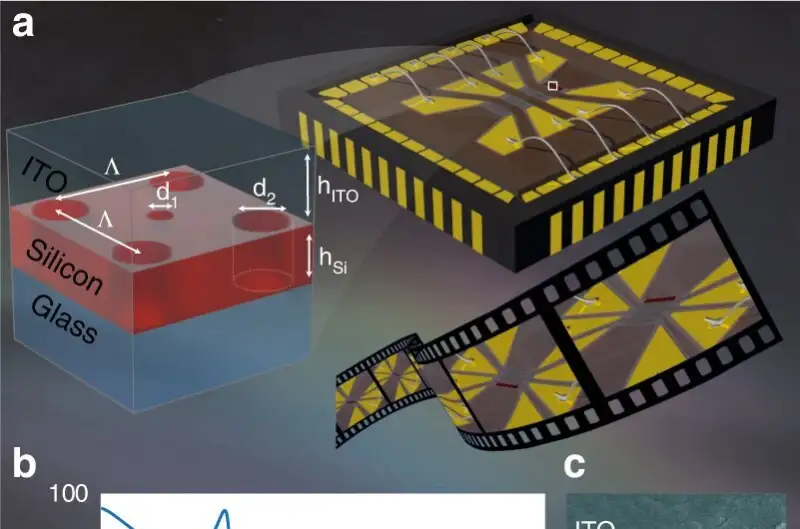Researchers have successfully developed a proof-of-concept technology that has the potential to revolutionize display technology beyond the limitations of current LCDs and LEDs. This breakthrough innovation, created by a collaborative team from Nottingham Trent University, the Australian National University, and the University of New South Wales Canberra, involves the use of electrically tunable arrays of nanoparticles known as “metasurfaces.” By utilizing metasurfaces, numerous advantages can be achieved, including thinner screens, higher resolution, and enhanced energy efficiency.
Presently, the display market offers a wide variety of options, each with its own advantages and disadvantages. However, factors such as production costs, lifespan, and energy consumption have ensured the continued dominance of liquid crystal technology in screens like televisions and monitors.
Liquid crystal cells are responsible for controlling the on/off state of transmitted light and are illuminated by a backlight. The inclusion of polarizing filters in front of and behind the pixels, along with liquid crystal cells, determines pixel size (resolution) and plays a crucial role in managing power consumption.
Nevertheless, the newly developed metasurface technology holds immense potential for overcoming the limitations of traditional liquid crystal displays. With the ability to electrically tune arrays of nanoparticles, this innovative technology offers significant improvements in terms of screen thickness, resolution, and energy efficiency. The advent of metasurfaces could usher in the next generation of displays, revolutionizing the way we perceive and interact with electronic devices.
A groundbreaking advancement has been made in display technology with the development of metasurface cells, which possess remarkable tunability and light scattering properties. These metasurface cells have the potential to replace the conventional liquid crystal layer in displays, eliminating the need for polarizers that contribute to significant light intensity and energy wastage.
Compared to liquid crystal cells, the metasurfaces are incredibly thin, being 100 times thinner, while also providing a tenfold increase in resolution and consuming 50% less energy.
In an impressive demonstration, the research team successfully showcased the electrical programmability of pixels and the ability to switch light nearly 20 times faster than the human aversion response time, achieved by manipulating the temperature of the material.
The researchers firmly believe that their technology is compatible with existing electronic displays and fills a crucial technological gap for tunable metasurfaces that can effectively switch light at high frequencies.
Professor Mohsen Rahmani, the leader of the project and an engineering expert at Nottingham Trent University’s School of Science and Technology and a Royal Society Wolfson Fellow, expressed his excitement about this breakthrough. He stated, “We have overcome a technological barrier by replacing the liquid crystal layer in current displays with a metasurface, allowing us to create liquid crystal-free flat screens at an affordable cost.”
He further emphasized the significance of key factors in flat panel displays, such as pixel size, resolution, weight, and power consumption, which have all been addressed with the introduction of the meta-display concept. This advancement has the potential to revolutionize the display industry, offering thinner, higher resolution screens with reduced power consumption.
This groundbreaking technology brings with it the potential for a significant reduction in energy consumption, which is particularly important given the widespread use of monitors and TV sets in homes and businesses on a daily basis. The researchers argue that it is time for LCD and LED displays to follow in the footsteps of cathode ray tube (CRT) TVs and be phased out.
According to Dragomir Neshev, Director of the ARC Center for Excellence in Transformative Meta-Optical Systems (TMOS) and Professor in Physics at the Australian National University, conventional displays have reached their limits and are unlikely to make substantial improvements in the future due to various limitations. There is now a demand for fully solid-state flat display technology that offers high resolution and fast refresh rates. The team has successfully designed and developed metasurface pixels that hold great promise for the next generation of displays.
Unlike liquid crystals, these new pixels do not rely on polarized light for their operation, leading to a 50% reduction in energy consumption. Khosro Zangeneh Kamali, a Ph.D. scholar at the Australian National University and the study’s first author, explains that metasurfaces exhibit extraordinary optical behavior, but effectively controlling them has been a subject of intense research. The team has proposed electrically programmable silicon metasurfaces as a versatile platform for programmable metasurfaces.
Dr. Lei Xu, a member of the team from Nottingham Trent University, highlights the potential for further improvements by incorporating artificial intelligence and machine learning techniques to design and realize even smaller, thinner, and more efficient metasurface displays.
Professor Andrey Miroshnichenko, another team member from the University of New South Wales Canberra, emphasizes that the silicon-based pixels offer a long lifespan compared to organic materials used in other existing alternatives. Additionally, silicon is readily available, compatible with mature CMOS technology, and cost-effective for production.
The researchers hope that this development will open up new frontiers in flat display technology. Their work has been reported in the journal Light: Science & Applications, showcasing the significance and potential impact of their findings.
Source: Nottingham Trent University

